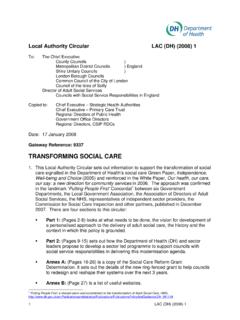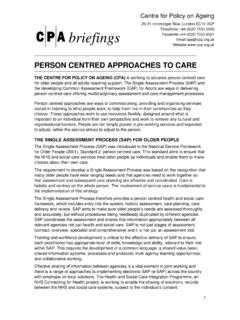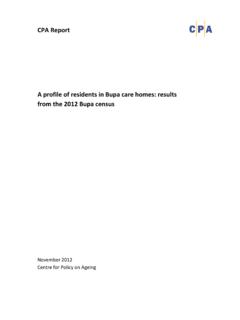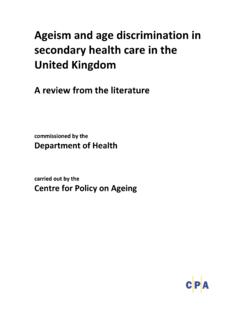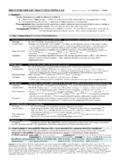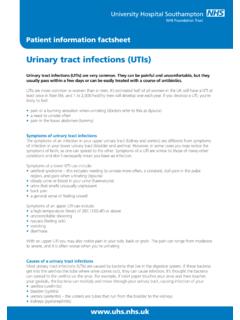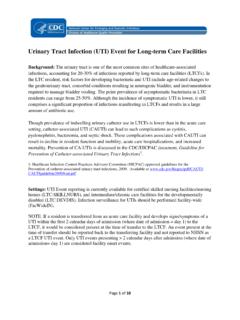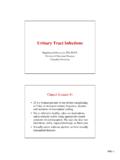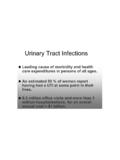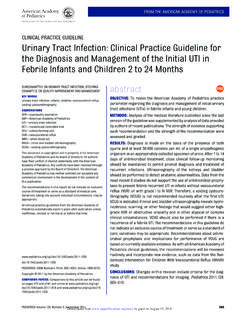Transcription of The prevention of urinary tract infections - CPA
1 Centre for Policy on Ageing Rapid review March 2014 The prevention of urinary tract infections Background urinary tract infection (UTI) is one of the most commonly acquired bacterial infections . It is the second most frequent bacterial infection in residents of long-term care facilities. Most infections are asymptomatic, with a prevalence of asymptomatic bacteriuria of 15% 50% among care home residents (Nicolle, 2013; Nicolle, 2000). Summary and key findings The use of antibiotics has generally been shown to be effective in the prevention of recurrent urinary tract infection.
2 A 3-day course of antibiotics may not be significantly less effective than a 7-day course (Vogel et al, 2004) and, since the over-use of antibiotics is to be avoided to maintain their overall effectiveness, other solutions have been sought. One study (Bleidorn et al, 2010) has shown that treating symptoms with ibuprofen is not significantly less effective than the use of antibiotics. Probiotic interventions have shown variable results in preventing the recurrence of UTIs depending on the type of probiotic used.
3 Lactobacillus rhamnosus GR-1 and Lactobacillus reuteri RC-14 may be effective but Lactobacillus GG drink less so. A number of small scale studies, over the years, have shown that cranberry derivatives, particularly tablets, and to a lesser extent juice, can be effective in preventing UTI, particularly for people at higher risk. A recently updated systematic review of cranberry treatments (Jepson, Williams and Craig, 2012) has however concluded that cranberry juice is not as effective as previously thought and suffers from a very high withdrawal/dropout rate.
4 Other interventions that may be effective include oral immunotherapy with Uro-Vaxom Escherichia coli (E. coli) extract, the use of vaginal oestrogens and HA-CS intravesical instillations. urinary tract infection is commonly associated with the use of catheters in care homes and hospitals. Guidelines to prevent infection indicate that the most effective measure is to avoid the use of catheters wherever possible (not using them as a routine intervention), to constantly monitor their use and to remove catheters at the earliest opportunity.
5 Alternative catheter designs and the use of anti-microbial materials to reduce the formation of biofilm show promise but have not yet been conclusively proved to be Centre for Policy on Ageing Rapid review March 2014 Review of evidence Pagea) Reviews, overviews and comparative studies 3 b) The use of antibiotics 8 c) The use of probiotics 15 d) Cranberry derivatives 18 e) Other interventions 31 f) Catheter acquired urinary tract infections (CAUTI) 36 The reviewed evidence is listed in reverse chronological order with the most recent evidence first.
6 2 Centre for Policy on Ageing Rapid review March 2014 a) Reviews, overviews and comparative studies Study Findings Eells S J, Bharadwa K, McKinnell J A and Miller L G (2014) Recurrent urinary tract infections Among Women: Comparative Effectiveness of 5 prevention and Management Strategies Using a Markov Chain Monte Carlo Model, Clinical Infectious Diseases 58 (2) : 147-160 A systematic literature review of management of women experiencing 3 or more UTIs per year was carried out.
7 The study then developed a Markov chain Monte Carlo model of recurrent UTI for each management strategy with 2 or more adequate trials published. The model simulated a cohort that experienced 3 UTIs/year and a secondary cohort that experienced 8 UTIs/year. Model outcomes were treatment efficacy, patient and payer cost, and health-related quality of life. Five strategies had 2 or more clinical trials published: (1) daily antibiotic (nitrofurantoin) prophylaxis; (2) daily estrogen prophylaxis; (3) daily cranberry prophylaxis; (4) acupuncture prophylaxis; and (5) symptomatic self-treatment.
8 In the 3 UTIs/year model, nitrofurantoin prophylaxis was most effective, reducing the UTI rate to UTIs/year, and the most expensive to the payer ($821/year). All other strategies resulted in payer cost savings but were less efficacious. Symptomatic self-treatment was the only strategy that resulted in patient cost savings, and was the most favourable strategy in term of cost per quality-adjusted life-year (QALY) gained. Conclusions: Daily antibiotic use is the most effective strategy for recurrent UTI prevention compared to daily cranberry pills, daily estrogen therapy, and acupuncture.
9 Cost savings to payers and patients were seen for most regimens, and improvements in QALYs were seen with all. 3 Centre for Policy on Ageing Rapid review March 2014 Beerepoot M A J, Geerlings S E, van Haarst E P, van Charante N M and ter Riet G (2013) Nonantibiotic Prophylaxis for Recurrent urinary tract infections : A Systematic Review and Meta-Analysis of Randomized Controlled Trials, The Journal of Urology 190 (6) : 1981-1989 This review identified 5,413 records and included 17 studies with data for 2,165 patients.
10 The oral immunostimulant OM-89 decreased the rate of urinary tract infection recurrence (4 trials, sample size 891, median Jadad score 3, RR , 95% CI ) and had a good safety profile. The vaginal vaccine Urovac slightly reduced urinary tract infection recurrence (3 trials, sample size 220, Jadad score 3, RR , 95% CI ) and primary immunization followed by booster immunization increased the time to reinfection. Vaginal estrogens showed a trend toward preventing urinary tract infection recurrence (2 trials, sample size 201, Jadad score , RR , 95% CI ) but vaginal irritation occurred in 6% to 20% of women.


